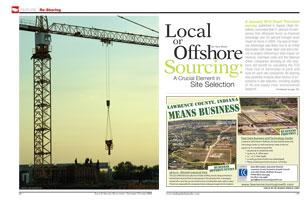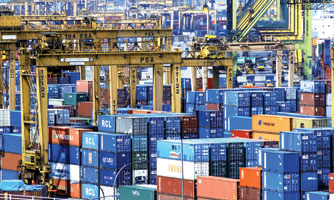
A January 2010 Grant Thornton survey, published in Supply Chain Solutions, concluded that 51 percent of companies that offshored found no financial advantage and 20 percent brought work closer to home in 2009. The lack of financial advantage was likely due to an initial fascination with lower labor cost and a failure to project offshoring’s total impact on revenue, overhead costs and the balance sheet. Companies deciding on site locations will benefit by calculating the TCO (Total Coat of Ownership) of parts and tools for each site considered. Re-shoring also positively impacts other factors of importance in site selection, including quality of life and supply chain environmental footprint.
The decline of U.S. manufacturing over the past several decades is a major cause of our high unemployment rate, massive trade deficit and huge budget deficit. Domestic suppliers have watched as large manufacturers off-shored work and jobs. But today, the dynamic is changing. Two U.S. trade associations, the National Tooling and Machining Association (NTMA) and the Precision Metalforming Association (PMA), are taking direct action to reverse the decline of manufacturing via the Re-Shoring Initiative.
The Re-Shoring (synonymous with “back-shoring” and “onshoring”) Initiative promotes returning work to the U.S. by assisting companies to more accurately assess their total cost of offshoring through the Total Cost of Ownership (TCO) Estimator.
Many companies that chose to offshore simply compared Free-on-Board (FOB) prices. The supply chain managers are often rewarded for savings at the FOB price level, ignoring a broad range of other costs and risks that disappear into lost sales, overhead or the balance sheet. The often ignored offshoring costs include:

Rising wage rates, currencies and reject rates in developing countries
Duty and freight
Pipeline and surge inventory impacts on balance sheets and Just-in-Time (JIT) operations
Intellectual property and regulatory compliance risk
Higher transportation and fuel costs
Higher prototyping costs (U.S. shops charge more for prototypes because they will not get the production)
Higher end-of–life obsolete inventory costs because of higher inventories when the design is changed or the product life ends
Less effective innovation because manufacturing operations are distant from R&D and marketing (loss of clustering effectiveness)
Travel and personnel cost
Carbon footprint
Companies that calculate their TCO will discover that they could re-shore substantial amounts of work and save money. The Re-Shoring Initiative's TCO Estimator software allows Original Equipment Managers (OEMs) to calculate and compare the total costs associated with outsourcing and offshoring. The Estimator includes 18 user-modifiable cost factors and makes it easy for an OEM to compare the full profitability impact of local versus offshore sourcing. The TCO is calculated for the present and then forecast based on user-projected wage inflation differentials and exchange rate changes. Job shops can use the Estimator to help their customers understand and calculate TCO.
For example, sourcing consultant Gibb River Group compared the U.S. and Chinese TCO of a low labor content, machined stainless steel gear. At FOB price level, the U.S. cost was 15 percent higher than the Chinese cost. However, costs were the same for producing the steel gear in each country after adding duty, freight, quality and inventory cost. The U.S. cost was 8 percent lower after allowing for end-of-life and prototyping cost differences - a 23 percent swing just by calculating cost correctly! Calculation of IP risk, proximity to R&D and carbon footprint would have widened the U.S. advantage even more.
A comparison of facility locations should include calculating and comparing each facility’s TCO of typical parts and tools. The company should also compare clustering benefits. Established research, including by Michael Porter, Professor at the Harvard Business School, shows that innovation and other important business processes occur most effectively when a company works closely with local universities, vendors and customers. It is far easier to innovate when your marketing, engineering and manufacturing functions are local, in the same time zone and speak the same language. Imagine the challenges when Engineering in the U.S. communicates with a Chinese manager who speaks Mandarin and involves a factory toolmaker who speaks only a Chinese dialect!
Economic development offices can use the re-shoring logic and software to help U.S. companies see the advantage of keeping production and other functions local or to show non-U.S. companies how much more competitive they will be if they locate a facility in the U.S., preferably near a major customer. PRTM’s 2010-2012 Supply Chain Trends Survey, taken in March 2010, showed that the biggest problem for supply chains is demand volatility, identified by 74 percent of respondents, more than twice the percentage identifying any other problem. The best way to respond to demand volatility is to shorten your supply chain so that it and you can respond quickly without increasing inventory.

Site selection is increasingly influenced by quality-of-life and environmental footprint concerns. How much benefit is there for managers and engineers to have their facility in paradise but to routinely make 2 a.m. phone calls to their factory in Asia or to make two- or three-week trips several times a year to audit compliance? Similarly, a company’s environmental footprint increases substantially if many components are manufactured in China with coal-fueled electricity and then shipped 12,000 miles to the U.S. in ships that have to return half-full because of the trade imbalance.
Lean and DFMA (Design for Manufacturability and Assembly) are other important tools for strengthening U.S. manufacturing by reducing wasted costs, including the higher labor cost which drives OEMs to offshore. Both processes are enhanced by local sourcing. Re-shoring reduces inventory, travel, quality and other non-value adding costs targeted by Lean and provides the proximity and common language and culture that make DFMA more effective.
Recently reported re-shorings had a range of causes similar to the offshoring costs listed above. These include:
Total cost, delivery and quality
Inventory build-up due to four month Chinese delivery
Total cost and the security of domestic supply
Capability not available in Mexico
Failure to honor warranty terms
Lack of a satisfactory Chinese solution (likely because the right alloys are not available).
The Re-Shoring Initiative’s objective is to change the mindset of U.S. supply chain managers from “offshored is cheaper” to “local reduces the Total Cost of Ownership.” We are providing the TCO cost accounting concept to help industry change its sourcing decision process. To achieve this major cultural change, our effort must be broad. We have created a surge of re-shoring publicity with numerous news stories as well as articles in newsletters and on websites. Our online Library contains 50 re-shoring examples so OEMs can see how competitors are benefiting from bringing work back to the U.S.
The Re-shoring Initiative has been featured in national print and television media. In addition to NTMA and PMA, we have received great support from the Association for Manufacturing Technology, the Society of Manufacturing Engineers, the Association for Manufacturing Excellence (AME) and the American Machine Tool Distributors' Association. AME/American Productivity & Quality Center (AME/APQC) and Fabricators and Manufacturers Association have recently hosted re-shoring webinars. The National Institute of Standards and Technology’s MEP (Manufacturing Extension Partnership) announced the AME/APQC webinar to the MEPs nationwide. Many local MEPs plan to use the initiative to help their client companies be more competitive.
In addition, our initiative helps these companies find the most competitive U.S. source through the NTMA/PMA Contract Manufacturing Purchasing Fairs: Emphasizing Re-shoring to Bring U.S. Manufacturing Jobs Home. The first re-shoring Fair was held in Irvine, California, on May 12, 2010. The next Fair is planned for Mashantucket, Connecticut, on October 29, 2010.
The NTMA has held 51 Purchasing Fairs in 25 years and NTMA and PMA have broadened the fairs. The fairs not only match OEMs and suppliers already sourcing domestically but also emphasize opportunities for re-shoring. The fairs provide a venue for OEMs to conveniently find competitive domestic job shops for custom machined, stamped, fabricated and injection molded parts, special tooling (molds, dies and fixtures) and special machines.
The May 12 NTMA/PMA Fair in Irvine was a re-shoring success. Fifty-seven OEMs attended and 64 percent of them brought work to be re-shored. One hundred and thirteen shops attended to provide quotes for the OEMs’ work. Fifteen cases of recent re-shorings were identified.
The time is right for re-shoring to succeed. Companies that were ravaged by excess inventory in the recent recession can reduce their inventory via local sourcing. Skilled wages in low labor cost countries have been rising at about 10-to-15 percent per year vs. 2 percent in the U.S. Recent major labor strikes in China have resulted in wage increases of 24-to-100 percent. Transportation costs are rising again as oil prices increase and OEMs who have sourced work overseas continue to report problems with quality, counterfeiting and intellectual property violations.
Before the crash in 2008, the trade deficit peaked at about $700 billion per year. Since manufacturing company sales average about $150,000/yr/job, about five million manufacturing jobs would be added if the trade deficit could be balanced by re-shoring. The accepted manufacturing multiplier of 1.4 means an additional seven million other jobs would be created. Thus a total of five to 12 million more jobs would be added, reducing U.S. unemployment to as low as two percent. The resulting increased income and corporate taxes and reduced unemployment and stimulus program expenses would cut the budget deficit by 30 percent or more. The rising tide of economic expansion would benefit all companies operating in the U.S. Ideally, companies should re-shore both the work shown by the TCO Estimator to be more profitable sourced domestically and also the marginal work that is still 3-to-5 percent more expensive sourced here. As all companies brought the marginal work back, the market for all companies would expand. For example, if the machine tool makers sourced their ball-screws here, the ball-screw makers would buy more machine tools here. Of course, for some goods, other changes are needed (e.g., a much higher Chinese currency, more domestic energy production, etc.).
The Obama Administration has called for doubling exports in five years and has threatened to tax companies that move jobs offshore. The Administration would strengthen the economy and employment more powerfully and faster by encouraging companies to embrace the Re-Shoring Initiative, showing the companies that it is in their own interest to keep the jobs here or bring them back. It is far easier for U.S. companies to be competitive on their home field than competing offshore.
You can help your company - and your country - via the Re-shoring Initiative. Please visit the initiative's website, www.PurchasingFair.com, where you can learn more about re-shoring, read examples of success stories from our library and report your own re-shoring successes. Managers and job shops can also register for the next fair on the website. Additional information also can be found at www.NTMA.org.
I ask you to support this effort, in the interest of your companies and of the quality of life of your children and grandchildren!
For more on the Re-Shoring Initiative and to obtain the free TCO Estimator, contact Harry Moser, leader of the Re-Shoring Initiative and Chairman Emeritus, Agie Charmilles LLC, at: harry.moser@comcast.net.

